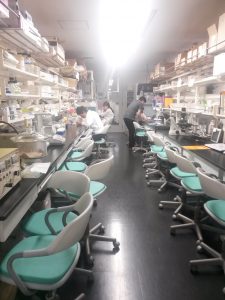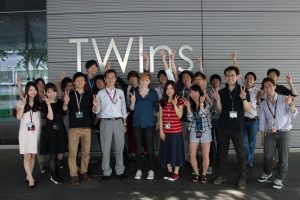
(photo: E. Beins)
Eva Beins recently completed a two-week internship at the Takeoka Lab in Tokyo, Japan to learn about “Nanosheet technology” and how to apply it to her PhD project. Eva is pursuing her PhD at the Institute of Molecular Psychiatry , where she studies the role of the endocannabinoid system in neuroinflammation and psychiatric disorders. Eva already specialized in her Masters on Neuroscience and is also member of the IITB program. Here, Eva reports on her impressions and experiences working in a Japanese lab:
Two weeks in the Takeoka Lab at the Center for Advanced Biomedical Sciences (TWIns), Waseda University, Tokyo
A few weeks ago, I stayed in Prof. Takeoka’s Lab in Tokyo to learn how to use Nanosheets – polymeric ultra-thin films in the nanometer range that can, depending on their composition, basically be applied to everything: wound healing, tissue engineering, ECG electrodes, oxygen-sensors, etc. The idea was that I could combine this technique with organotypic hippocampal slice cultures. I am using these cultures in my PhD project in which I study the role of the endocannabinoid system in neuroinflammatory processes.

Takeoka Lab (photo: E. Beins)
After two days of sightseeing in Tokyo, and, yes, it’s really how you imagine it: huge streets and buildings, neon lights, people in weird costumes, crowded but at the same time extremely clean and organized, I started my two-week program in the lab.
So, what are the differences between working in a lab and doing your PhD in Tokyo compared to Bonn?
First of all, the lab at TWIns basically consists of one big room, with at least 50 Bachelor, Master and a few PhD students from several groups doing their experiments. That definitely makes you appreciate how much space you have in your German lab. But it’s fascinating how many different techniques and research topics can be covered in the same lab – ranging from genetics and molecular biology to electrophysiology, drug design and delivery, tissue engineering, nanotechnology, and much more.
I guess everyone has this image of Japanese people working until late at night, and I have to say: it’s completely true. Apparently, they don’t need to sleep – except when they are riding the subway. Okay, they start a bit later than we usually do in Germany, but being the first one to leave around 7 p.m. was kind of new to me.
But, of course there are things that are quite similar during a PhD in Japan and Germany. During my two weeks there, one of the PhD students got a paper published (congrats!) and another one, in her last year, literally worked day and night to generate data before starting to write it all down. She even took me to the airport at 5 a.m. when she had some time to kill during a long incubation for her experiment.
In the end, I guess, a PhD is a PhD and never a bed of roses. But, at the same time, it’s the time you can actually do things – like going to Tokyo for two weeks. And I can definitely recommend doing something like this to everybody! If it wasn’t for the cooperation between Bonn and Waseda University, I would have probably never heard of Nanosheets, much less know how to use them for my hippocampal slice cultures. And, who knows, maybe everything will work out really well, and the technique will change my whole PhD project. Or, if it doesn’t work out, then I still was in Tokyo for two weeks and had the chance to learn what it´s like to work in a Japanese lab and to meet a lot of nice people.

(photo: E. Beins)
Author: Eva Beins
